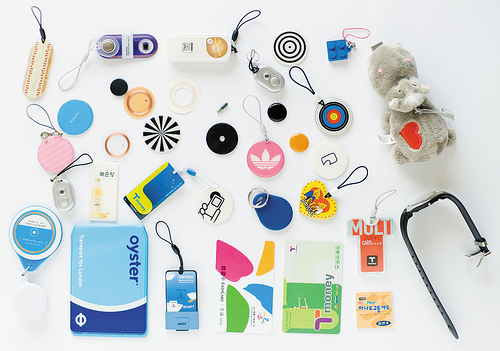How Does RFID Work?
So, How does RFID Work? You Ask!
An RFID reader transmits an encoded radio signal to read the microchip (tag). The RFID microchip receives the message and then responds with its identification and other information. This may be only a unique microchip serial number, or may be product-related information such as a stock number, lot or batch number, production date, or other specific information. Or in the case of a credit card or bank card the personal information about the card holder and the access details of your accounts.
Readers
RFID systems can be classified by the type of Chip (Tag) and Reader
A Passive Reader Active Tag (PRAT) system has a passive reader which only receives radio signals from active tags (battery operated, transmit only). The reception range of a PRAT system reader can be adjusted from 1–2,000 feet (0.30–609.60 m), allowing flexibility in applications such as asset protection and supervision.
An Active Reader Passive Tag (ARPT) system has an active reader, which transmits interrogator signals and also receives authentication replies from passive tags.
An Active Reader Active Tag (ARAT) system uses active tags awoken with an interrogator signal from the active reader. A variation of this system could also use a Battery-Assisted Passive (BAP) tag has a small battery to power the tag’s return reporting signal.
Uses
The RFID tag can be affixed to an object and used to track and manage inventory, assets, people, etc. For example, it can be affixed to cars, computer equipment, books, mobile phones, consumer products, etc.
Major Advantages of RFID Devices
RFID offers advantages over manual systems and the use of bar codes. The tag can be read if passed near a reader, even if it is covered by the object or not visible. The tag can be read inside a case, carton, box or other container, and unlike barcodes, RFID tags can be read hundreds at a time. Bar codes can only be read one at a time using current available devices.
RFID can be used in a variety of applications including:
• Access management,
• Asset tracking,
• Tracking of physical goods,
• Tracking of persons and animals,
• Toll collection and contactless payment.
• Machine readable travel documents – passports, etc…,
• Smartdust (for massively distributed sensor networks),
• Tracking sports memorabilia to verify authenticity,
• Airport baggage tracking logistics,
• Timing sporting events,
• Passport authentication,
• Credit Card identification,
• Personal Identification cards.
In recent years three factors have driven a significant increase in RFID usage:
• Decreased cost of equipment and microchips,
• Increased performance to a reliability of 99.9%, and
• A stable international standard around UHF passive RFID.
The use of RFID technologies continues to grow as industries find new ways to utilize this amazing technology.
However, all new technologies have their risks. RFID is no exception.
Upcoming Article:
Again, look out for our next article in this series – “What are the Uses of RFID Devices?” You will find it informative and fascinating reading. Click HERE to read this article.
Protecting your RFID device from scammers is easy! This product is your solution.
Image: MF381: Figure 9.8 by Rosenfeld Media


